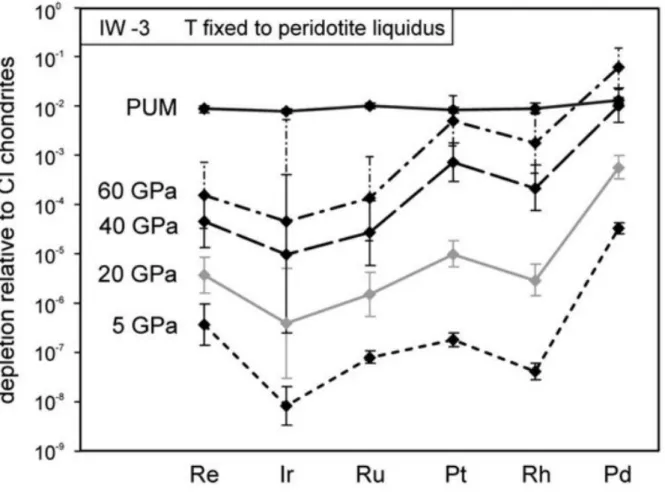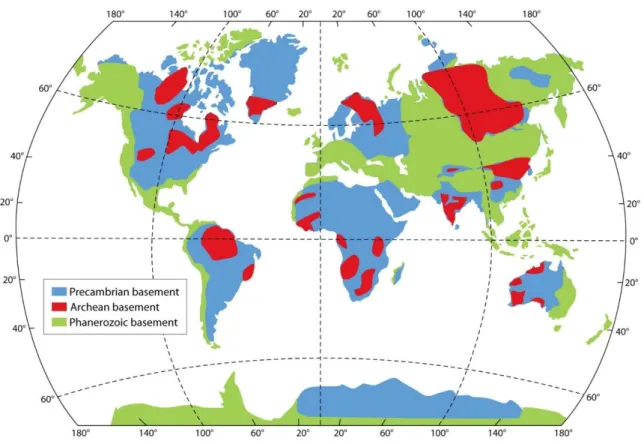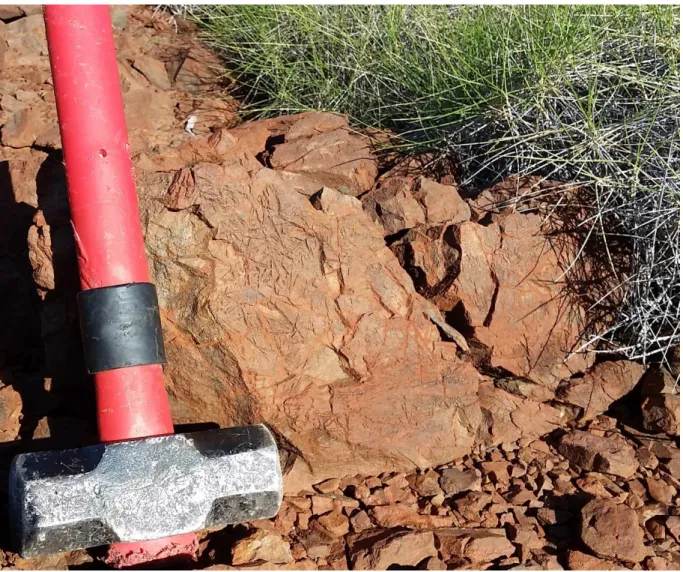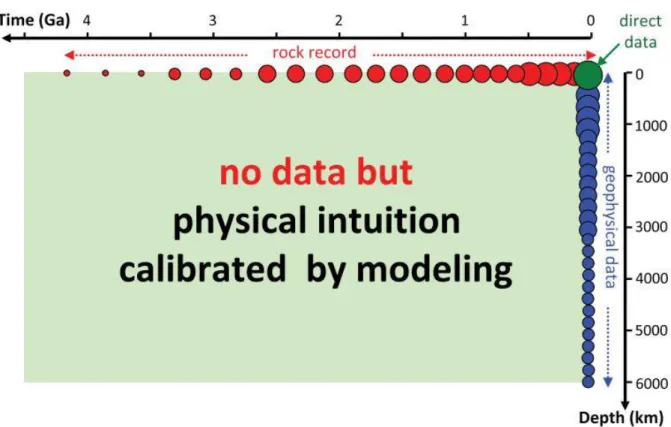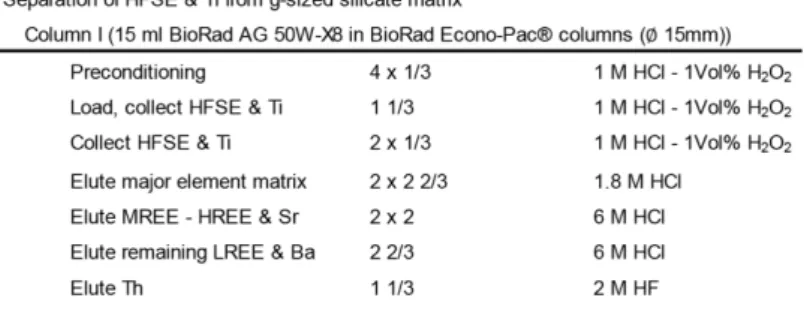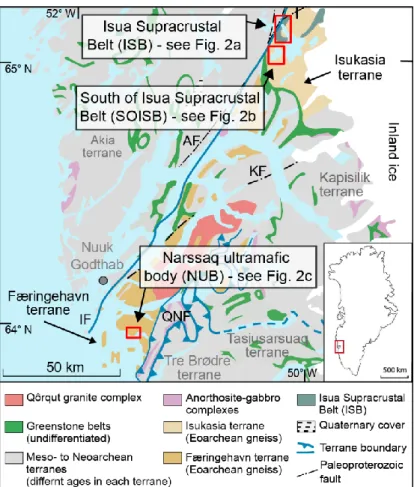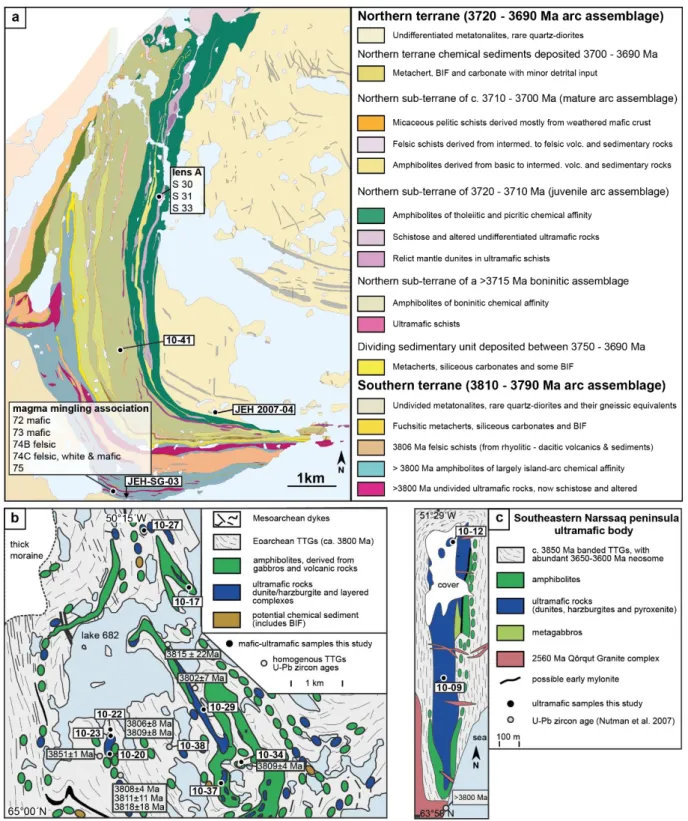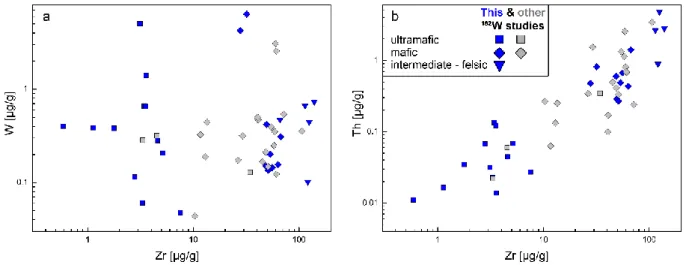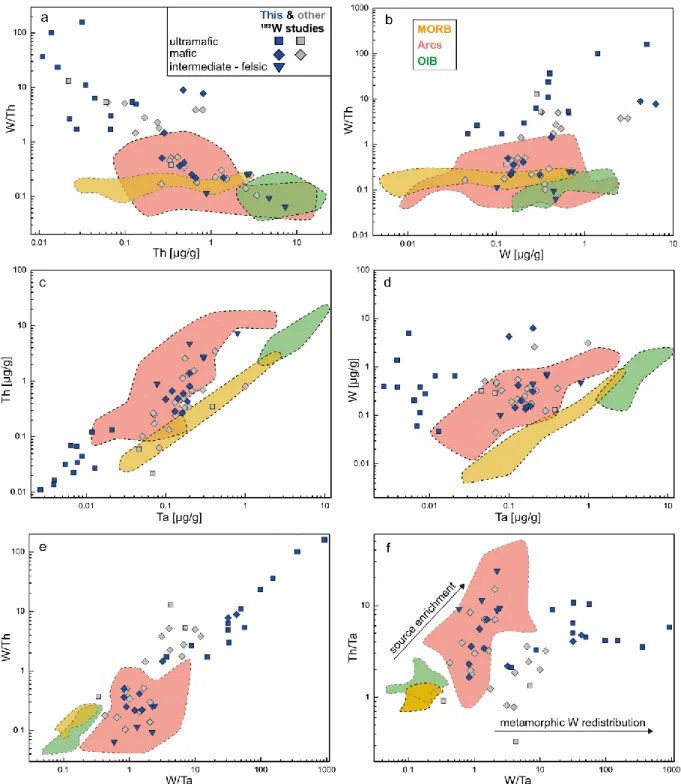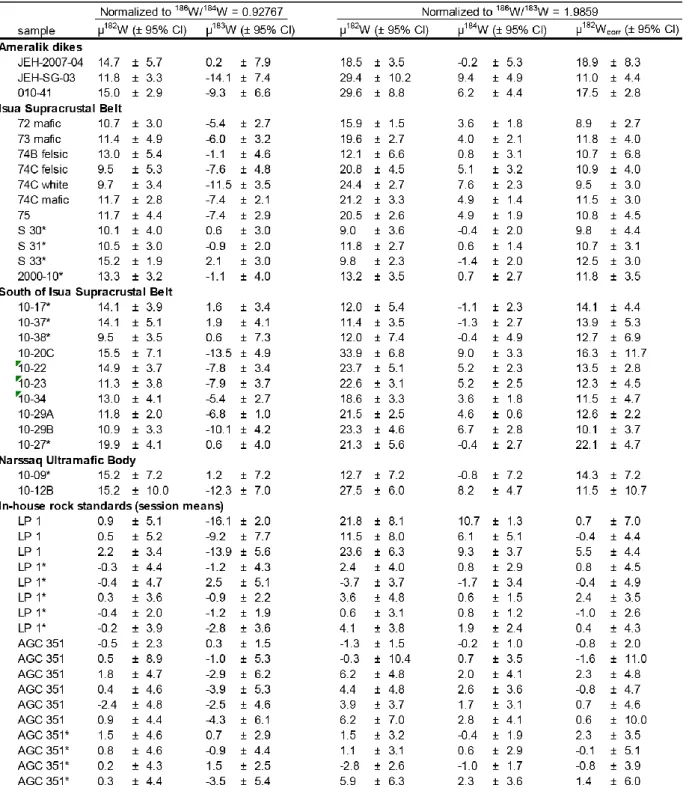Tungsten isotope constraints on Archean geodynamics
Inaugural-Dissertation zur
Erlangung des Doktorgrades
der Mathematisch-Naturwissenschaftlichen Fakultät der Universität zu Köln
vorgelegt von
Jonas Tusch
aus Meerbusch
Köln, 2020
II
Berichterstatter: Prof. Dr. Carsten Münker PD Dr. Daniel Herwartz Dr. Kristoffer Szilas
Tag der mündlichen Prüfung: 10.09.2020
IV
This thesis is dedicated to my wife Lena
V
I. Abstract ... 1
II. Kurzzusammenfassung ... 3
III. Introduction ... 6
Origin and evolution of the Earth ...6
Early Earth Processes (Moon-forming impact, accretion history, late veneer) ...7
Tectonic Regimes, Archean rocks and their spatial distribution ... 10
Application of short-lived isotope systems ... 14
Mobility and secondary overprint of W and the implication for 182W anomalies ... 16
182W isotope systematics of the terrestrial mantle ... 16
Significance of constraints on the dynamics of Early Earth processes ... 19
IV. Sythesis ... 21
1 Uniform
182W isotope compositions in Eoarchean rocks from the Isua region, SW Greenland: the role of early silicate differentiation and missing late veneer ... 25
1.1 Abstract ... 25
1.2 Introduction ... 26
1.3 Methods ... 28
1.3.1 Whole rock major, trace element and isotope dilution measurements (HFSE, Th & U) 29 1.3.2 Ion exchange protocol for high precision W isotope measurements ... 30
1.3.3 Mass spectrometry for high precision 182W isotope measurements ... 34
1.4 Geological background and samples ... 37
1.5 Results ... 43
1.6 Discussion ... 48
1.6.1 Methodology ... 48
1.6.2 Elemental behavior of W in rocks from the Isua region ... 53
1.6.3 Significance of uniform 182W isotope compositions ... 57
1.6.4 Significance of the 182W and W/Th signatures in mantle-like peridotites ... 59
1.6.5 Origin of 182W isotope anomalies in SW Greenland ... 60
1.7 Conclusion ... 64
VI
2.1 Abstract ... 66
2.2 Introduction ... 67
2.3 Geological background and samples ... 68
2.4 Results ... 71
2.5 Discussion ... 75
2.6 Conclusion ... 77
2.7 Method Section ... 78
2.7.1 Analytical protocol ... 78
2.7.2 Geological background ... 81
2.7.3 Sample selection ... 83
2.7.4 Secular evolution of 182W isotope anomalies ... 86
3 Long-term preservation of Hadean protocrust in Earth´s mantle ... 88
3.1 Abstract ... 88
3.2 Introduction ... 89
3.3 Geological and methodological overview ... 90
3.4 Results ... 90
3.5 Discussion ... 91
3.6 Conclusions ... 101
3.7 Method section ... 101
3.7.1 Geological background of our sample selection ... 101
3.7.2 Lower protocrust delamination model ... 106
3.7.3 Analytical protocol ... 110
References ... 113
Appendix ... 137
Appendix A... 137
Appendix B... 145
Appendix C... 159
Acknowledgements ... 165
Erklärung ... 167
1
I. Abstract
Geodynamics on Earth are active since more than 4 billion years and have continuously lead to differentiation and homogenization of mantle and crust. However, evidence from short-lived nuclide decay systems (e.g.
129I –
129Xe and
146Sm –
142Nd) suggest that primordial heterogeneities, which formed in the early Hadean Eon (i.e.
during the first ca. 100 million years after formation of the Earth), survived for a long period of time – in some cases for Eons and until present day. Studying rocks that display variations in the decay products of short-lived nuclide decay systems offer two intriguing perspectives: (1) The cause for their formation refers to processes that must have had operated at a time when no other witnesses preserved in the geological rock record. (2) Understanding the mechanisms that allowed for their long-term preservation provides important insights into the temporal evolution of the bulk silicate Earth (BSE) and into the processes that lead to the present-day state of the mantle, including the onset of plate tectonic processes on Earth.
One of the short-lived decay series that has increasingly been applied in geochemistry
is the
182Hf-
182W decay system with a half-life of 8.9 million years (Vockenhuber et al.,
2004)). Over the past decade, several studies investigated W isotope systematics in
terrestrial rocks and found differences in the relative abundance of
182W. While
Archean rocks were found to exhibit predominantly elevated
182W isotope compositions
compared to the modern depleted mantle, modern oceanic island basalts (OIBs) and
one Archean komatiites system (the ca. 3.55 Ga Schapenburg komatiite suite from the
Kaapvaal Craton, southern Africa) were shown to display negative anomalies. These
findings were interpreted as evidence for the preservation of early-formed
heterogeneities in the sources of Archean rocks and taken as evidence for the
presence of primordial mantle components that participate to the provenance of
modern igneous reservoirs. However, the processes that lead to the formation of these
reservoirs remained ambiguous. These processes include (1) incomplete equilibration
of the mantle source with late accretionary material (late accretion hypothesis), (2)
early fractionation of Hf from W by silicate crystal-liquid fractionation, e.g., in an early
magma ocean, or (3) core-mantle interaction. Matters are further complicated because
secondary processes (fluid-mediated alteration) often obscured primary W budgets of
metamorphosed Archean rock assemblages and the analytical standards to obtain
2
high-precision
182W isotope measurements turned out to be challenging.
In this study, an analytical protocol is presented to obtain high-precision
182W isotope measurements on samples with low bulk-rock W concentrations (several ng/g). In three chapters we report high-precision
182W isotope data for Archean rocks from the ca.
3.9-3.6 Ga Itsaq Gneiss Complex of southern West Greenland (chapter 1), the ca.
3.6-3.2 Ga Pilbara Craton, NW Australia (chapter 2), and the ca. 3.6-3.2 Ga Kaapvaal
Craton, southern Africa (chapter 3). In all studies, we combine
182W isotope analysis
with high-precision isotope dilution measurements for high field strength element
(HFSE), U, and Th abundances, to assess the elemental W systematics in our
samples. This allows us to obtain a precise understanding of the primary and
secondary processes that modified the W abundances and isotope compositions. As
we demonstrate, the elemental W budgets of many mantle-derived rocks are
dominated by metasomatic agents that mix reservoirs of variable
182W isotope
compositions and obscure primary signatures (chapters 1 and 2). If not taken into
consideration, this can lead to ambiguous interpretations of
182W isotope compositions
observed in Archean lithostratigraphic successions. Our studies on rocks from different
Archean cratons reveal that several processes are responsible for the origin of
182W
isotope anomalies. Excesses of
182W in rocks from the Pilbara Craton (chapter 2) are
best explained by missing late accreted additions in their mantle sources. Anomalies
in rocks from the Itsaq Gneiss Complex (chapter 1) and the Kaapvaal Craton (chapter
3) instead were inherited from mantle sources that underwent early silicate
differentiation during the lifetime of
182Hf (i.e. in the first ca. 60 million years after Solar
System formation). Our results demonstrate that these Hadean signatures remained
isolated in the mantle for several hundred million years. Understanding the evolution
of
182W isotope systematics in the BSE through time requires comprehensive studies
of lithostratigraphic successions that cover relatively long time frames of Archean
geodynamic evolution, as shown by our study on the geological rock record of the
Pilbara Craton (chapter 2). We further demonstrate that information about the
temporal evolution of
182W isotope systematics of individual cratons is archived in
Archean shales, which provide an average of the
182W isotope composition of the upper
crust (chapter 2). These findings allow for observational constraints, which have
important implications for understanding timescales of geodynamic processes on the
early Earth (e.g. mantle stirring rates). As reported in chapter 3, rocks from the
Kaapvaal Craton display correlations between
182W isotope compositions and initial
3
εNd
(t)and εHf
(t)values. To our knowledge, this is the very first co-variation observed between
182W isotope systematics and long-lived radiogenic nuclides (
147Sm-
143Nd and
176
Lu-
176Hf systematics). The only plausible model to explain these patterns is the presence of recycled mafic restites from Hadean protocrust in the ancient mantle beneath the Kaapvaal Craton. As further demonstrated by our model, the striking isotopic similarity between recycled restites from Hadean protocrust and the low
182W endmember of modern OIBs might also be the missing link bridging
182W isotope systematics in Archean and young mantle-derived rocks. This finding offers important constraints on the geodynamic evolution of Earth’s mantle through time, indicating inefficient homogenization of Hadean silicate reservoirs.
II. Kurzzusammenfassung
Seit über vier Milliarden Jahren haben geodynamische Prozesse kontinuierlich zur Homogenisierung und Differenzierung des Erdmantels und der kontinentalen Kruste geführt. Allerdings gibt es Hinweise von kurzlebigen Zerfallssystemen (z.B.
129I –
129Xe und
146Sm –
142Nd), das primordiale Heterogeneitäten, welche sich im Hadaikum gebildet haben (d.h. während der ersten ca. 100 Millionen Jahre nach Entstehung der Erde), über sehr lange Zeiträume erhalten geblieben sind – in einigen Fällen über Äonen und bis zum heutigen Tag. Die Untersuchung von Isotopenvariationen von Nukliden kurzlebiger Zerfallssysteme an terrestrischen Gesteinen sind in zweierlei Hinsicht von Bedeutung: (1) Die Ursache für die Entstehung der Variationen verweist auf Prozesse die zu einem Zeitpunkt stattgefunden haben müssen von dem keine weiteren geologischen Zeugen erhalten geblieben sind. (2) Das Verständnis der Mechanismen, welche für die Erhaltung dieser primordialen Signaturen verantwortlich sind, erlaubt Rückschlüsse über die zeitliche Entwicklung der Silikaterde und über Prozesse welche den Zustand des heutigen Erdmantels herbeigeführt haben (z.B.
Einsetzen moderner Plattentektonik).
Ein kurzlebiges Zerfallssystem welches in der Geochemie intensiv verwendet wird ist
182
Hf-
182W (Halbwertszeit 8.9 Millionen Jahre (Vockenhuber et al., 2004)). Innerhalb
des letzten Jahrzehnts fanden mehrere Studien in terrestrischen Gesteinen
Unterschiede in den relativen Häufigkeiten von
182W.
4
Während Gesteine aus dem Archaikum im Verhältnis zum heutigen verarmten Mantel vorwiegend erhöhte
182W Zusammensetzungen aufweisen, finden sich für moderne Ozean Inselbasalte (OIB) und eine Suite archaischer Komatiite (die 3.55 Milliarden Jahre alten Schapenburg Komatiite aus dem Kaapvaal Kraton im südlichen Afrika) negative Anomalien. Dies wurde als Nachweis für die Erhaltung von primordialen Domänen im Erdmantel und deren Partizipation bei der Bildung moderner Mantelschmelzen interpretiert. Allerdings besteht Uneinigkeit darüber welche Prozesse für die Bildung dieser Manteldomänen verantwortlich sind. Diskutiert wird (1) die unvollständige Äquilibrierung mit Material aus der Spätphase der Akkretion (late accretion hypothesis), (2) frühe Fraktionierung von Hf und W während Kristall – Silikatschmelz Fraktionierung, z.B. zu Zeiten eines frühen Magma-Ozeans, oder (3) Interaktion zwischen Erdkern und Erdmantel. Weiterhin kommt erschwerend hinzu, dass die W Gehalte metamorph überprägter archaischer Gesteine durch sekundäre Prozesse verändert wurden (fluidkontrollierte Alteration) und die analytischen Standards für Hochpräzisionsmessungen von
182W höchst anspruchsvoll sind.
In dieser Studie präsentieren wir ein analytisches Protokoll, welches die Durchführung von Hochpräzisionsmessungen von
182W an Gesteinen ermöglicht die eine geringe W Konzentration aufweisen (wenige ng/g). In drei Kapiteln stellen wir die Ergebnisse unserer
182W Isotopenstudien vor die wir an Archaischen Gesteinen durchgeführt haben. Dies umfasst den 3.9-3.6 Milliarden Jahren alten Itsaq Gneiss Complex von SW Grönland (Kapitel 1), den ca. 3.6-3.2 Milliarden Jahre alten Pilbara Kraton, NW Australien (Kapitel 2), sowie den ca. 3.6-3.2 Milliarden Jahre alten Kaapvaal Kraton im südlichen Afrika (Kapitel 3). In allen drei Studien kombinieren wir unsere
182W
Daten mit hoch präzisen Konzentrationsbestimmungen
(Isotopenverdünnungsanalysen) für Elemente hoher Feldstärke (high field strength elements, HFSE), U und Th um das elementare Verhalten von W in unserem Proben zu evaluieren. Dies dient dem Verständnis von primären und sekundären Prozessen welche eine Veränderung der W Gehalte und W Isotopenzusammensetzungen herbeiführen können. Wie wir zeigen werden sind die W Konzentrationen in vielen Mantelgesteinen von metasomatischen Prozessen dominiert. Dadurch können primäre Signaturen überprägt werden, da Reservoire unterschiedlicher W Isotopenzusammensetzung miteinander gemischt werden (Kapitel 1 und Kapitel 2).
Wenn dies nicht berücksichtigt wird kommt es zu falschen Interpretationen von
182W
Isotopendaten an archaischen Gesteinen. Unsere Studien an Gesteinen aus
5
verschiedenen archaischen Kratonen bezeugen, dass unterschiedliche Prozesse als Ursache für
182W Isotopenanomalien verantwortlich sind. Erhöhte
182W Isotopenhäufigkeiten in Gesteinen aus dem Pilbara Kraton (Kapitel 2) lassen sich durch die unvollständige Äquilibrierung mit Material der späten Akkretionsphase der Erde erklären. Anomalien in Gesteinen aus dem Itsaq Gneiss Complex (Kapitel 1) und dem Kaapvaal Kraton (Kapitel 3) hingegen sind auf Mantelquellen zurückzuführen welche zu Lebzeiten von
182Hf (d.h. innerhalb der ersten 60 Millionen Jahre nach Entstehung des Sonnensystems) eine Silikatdifferenzierung erfahren haben. Unsere Ergebnisse zeigen auf, dass Reservoire, welche diese primordialen Signale archivieren, für mehrere hundert Millionen Jahre isoliert wurden. Wie unsere Analysen der geologischen Formationen aus dem Pilbara Kraton zeigt (Kapitel 2), sind umfangreiche Studien an Gesteinsformationen erforderlich, welche lange Zeiträume archaischer geodynamischer Prozesse archivieren, um die zeitliche Entwicklung der
182
W Isotopenzusammensetzung der Silikaterde verstehen zu können. Unsere Forschung kann weiterhin darlegen, dass archaisches Schiefergestein Informationen über die zeitliche Entwicklung der
182W Isotopenzusammensetzung für einzelne Kratone liefert, da Schiefergestein repräsentativ für die obere kontinentale Kruste ist.
Diese Erkenntnisse ermöglichen die Erhebung wissenschaftlicher Daten welche für
das Verständnis von Zeiträumen geodynamischer Prozesse (z.B. Zeiträume der
Mantelkonvektion), wie sie in der frühen Erde abgelaufen sind, von großer Bedeutung
sind. Wie in Kapitel 3 aufgezeigt, weisen archaische Gesteine aus dem Kaapvaal
Kraton Korrelationen zwischen ihren
182W Isotopenzusammensetzungen und initialen
εNd
(t)- sowie εHf
(t)-Werten auf. Nach unserem Kenntnisstand ist eine solche
Korrelation zwischen
182W und langlebigen Radionukliden (in diesem Fall die
Isotopensysteme
147Sm-
143Nd und
176Lu-
176Hf) bislang einmalig. Die Partizipation
recycelter mafischer Restite hadaischer Protokruste während der Petrogenese ist das
einzige Modell welches diese Korrelation erklären kann. Weiterhin zeigen unsere
Modellierungen, dass es eine auffallende Ähnlichkeit in der isotopischen
Zusammensetzung zwischen den recycelten Restiten hadaischer Protokruste und
einem Endglied moderner OIBs gibt welche besonders negative
182W
Isotopenanomalien aufweist. Dies kann den missing link für die
182W
Isotopensystematik zwischen archaischen und rezenten Gesteinen darstellen. Unsere
Forschungsergebnisse bezeugen die ineffiziente Homogenisierung
6
hadaischer Reservoire und liefern bedeutende Erkenntnisse für die geodynamische Entwicklung des Erdmantels.
III. Introduction
Origin and evolution of the Earth
Studying the oldest terrestrial rocks allows us to address important questions not only to the primordial stages of our planet, but also to the early evolution of our Solar System and planetesimals in general. Knowledge about the initial stages of terrestrial planets is an important prerequisite to understand how planets became habitable, and how life evolved and became sustainable.
Models for Solar System and terrestrial planet formation were summarized in previous review papers (Chambers, 2004; Williams and Cieza, 2011; Norman, 2019) and mainly rely on astronomical observations from other solar systems, the geochemical properties of the Earth and meteorites, and the structure of our Solar System. Based on these constraints terrestrial planetary formation is the result of multistage processes that began with the collapse of a solar nebula within a cold and dense molecular cloud into a rotating protoplanetary disk. After the dust became concentrated in the midplane of the disk, it accreted to bodies that were dubbed planetesimals (~10 – 100km diameter). This happened during the very first few million years of the Solar System.
Witnesses of these early stages are meteorite fragments of large parent bodies that accumulated from earliest formed detritus. Thus, components from meteorites offer important insights into nebular and asteroidal processes such as absolute age constraints for earliest formed solids (calcium-aluminium-rich inclusions) of our Solar System that date back to 4.568 billion years (Bouvier and Wadhwa, 2010).
Subsequently, the accretion of material in the protoplanetary disk evolved to planetary
embryos (~100 – 5000km diameter) mainly as a result of gravitational interactions
(runaway growth) that culminated in oligarchic growth, where the largest planetary
embryos grew at the expanse of smaller planetary embryos. The final stage of
accretion from embryos to planets was highly chaotic and slower than the initial
material coagulation processes because the mechanics of growth were mainly caused
by gravitational perturbations between a few dozen embryos, where the outcome of
individual events dictated the evolutionary pathway for a solar system. This last stage
of terrestrial planet formation was characterized by multiple highly energetic collisions
7
(O’Brien et al., 2006) that caused a series of magma ocean events with fundamental consequences for core formation (Rubie et al., 2007; Rubie et al., 2011). Most likely, one of these highly energetic collisions was responsible for the formation of the Earth- Moon system (Canup, 2012).
Early Earth Processes (Moon-forming impact, accretion history, late veneer)
Many dynamical scenarios have been considered to explain the formation of the Earth- Moon system, for instance loss of material from a fast-spinning proto-Earth (Ćuk and Stewart, 2012) or being the product of multiple impacts (Rufu et al., 2017). However, most models are in favor of a giant-impact hypothesis which assumes that the Moon grew gravitationally from debris in a circumterrestrial disk that remained after a large collision between the proto-Earth and a Mars-sized planetesimal named Theia (Hartmann and Davis, 1975; Cameron and Ward, 1976; Cameron, 1997; Canup and Asphaug, 2001). The giant Moon-forming impact seems to be the most plausible scenario as it can reconcile for many observations such as the nearly identical isotopic composition between the Earth and Moon, the angular momentum of the Earth-Moon system, the level of lunar volatile depletion and the depletion in Fe-Ni as implied by the Moon´s low bulk density (Melosh, 2014). The timing of the Moon-forming impact is still highly debated but was probably close the end of primary accretion, maybe as early as 50 Ma after the formation of the Solar System (Thiemens et al., 2019).
It is in general challenging to estimate the exact timing for the formation of the terrestrial
planets of our Solar System because it is difficult to disentangle the processes of core
formation and accretion. As already mentioned, planetesimal accretion and core
formation most likely represent protracted periods that occurred contemporaneously
(Kramers, 1998). One chronometer that was often applied to date core formation on
asteroids and Earth is the extinct
182Hf –
182W system (half-life 8.9 million years
(Vockenhuber et al., 2004)). The short half-life provides an excellent time resolution to
determine the timescale for Earth´s core formation. Furthermore, its parent and
daughter isotopes show markedly different geochemical affinities during metal-silicate
differentiation. Hafnium behaves strongly lithophile and mainly remained in the bulk
silicate Earth (BSE), while W is a moderately siderophile element that was strongly
sequestered into the metallic core (e.g. Rammensee and Wänke, 1977; Palme and
8
Rammensee, 1981). Thus, the early BSE (< 60 Ma after solar system formation) had elevated Hf/W, which caused a stronger radiogenic ingrowth of
182W when compared to the Earth´s core or Chondrites, a meteorite group that remained undifferentiated and is taken as a canonical reference for the bulk Earth composition (Harper and Jacobsen, 1996; Kleine et al., 2002; Schoenberg et al., 2002b; Yin et al., 2002). Therefore, accretion and metal-silicate fractionation chronologies on planetary bodies are calculated relative to the chondritic
182Hf –
182W isotope evolution. Assuming that core formation was a single stage process that took place in a short, “catastrophic” event, a maximum age of 38 Ma after Solar System formation is obtained (König et al., 2011).
This maximum age for core formation probably also constrains the final stages of accretion as the latter process was shown to sustain core formation (Kramers, 1998).
Elements that behave chalcophile or siderophile should be highly depleted in the BSE
as they were nearly completely removed by segregating into Fe-alloys during core-
formation (McDonough, 2013). However, the absolute abundances for highly
siderophile elements (HSE, e.g. platinum-group elements (PGE), Re, Au) are
substantially higher than expected from their metal-silicate partitioning behavior during
core-formation (Walker, 2009; Mann et al., 2012; Siebert and Shahar, 2015). Even
more surprising, HSE display near-chondritic relative abundances, although their
experimentally derived metal-silicate partitioning behavior would suggest strong
fractionation during core-formation (Walker, 2009; Mann et al., 2012; Siebert and
Shahar, 2015) (see Fig. III.1). Based on these observations it has been proposed that
the Earth accreted material with chondritic bulk HSE compositions after equilibrium
partitioning and chemical interexchange between mantle and core had ceased (Kimura
et al., 1974; Chou, 1978; Wänke et al., 1984). This late accretion of a small fraction
(~0.5% of the mass of the mantle (Walker, 2009)) of material with bulk chondritic
composition has been termed late veneer (Chou, 1978). The replenishment of HSE
during the final stages of Earth´s accretion was also related to the late heavy
bombardment (Chou, 1978), which was a period of intense cratering and basin
formation. This bombardment continued for several hundred million years after
formation of the Solar System as inferred from age constraints in lunar impact rocks
and “photogeological” observations on other bodies such as Mars, Mercury, Mimas
and Callisto (Tera et al., 1974; Kring and Cohen, 2002). However, but this is only my
personal view, both terms are grounded on different observational constraints and it
9
should be allowed to discuss if the late veneer falls (at least in part) in the period of the late heavy bombardment, but for semantics the terms should always be kept separately. Moreover, it has been pointed out that both terms (late veneer and late heavy bombardment) are not synonymous (Carlson et al., 2015) because constraints from recent studies (Norman et al., 2010; Miljković et al., 2013) suggest that the contribution from the late heavy bombardment, was too small to have any consequences for the bulk composition of Earth.
Besides elemental systematics from HSE abundances in terrestrial rocks there are also isotopic constraints on the contribution and nature of a putative late veneer. Since analytical improvements have improved the precision for
182W isotope measurements into a range of <5ppm (Willbold et al., 2011; Touboul et al., 2012) it has been documented that Archean rocks are predominantly enriched in the isotope
182W relative to the modern mantle. The modern-mantle value is inferred from certified
Figure III.1: Highly siderophile element concentrations, normalized to CI chondrite, predicted for the primitive upper mantle (PUM) as a result of metal-silicate partitioning at various P-T conditions in a magma ocean. Taken from Mann et al. (2012).
10
standard solutions, either NIST SRM 3163 or AMES W-metal, which both have similar
182
W isotope abundancies (Peters et al., 2014). Primitive meteorites of bulk chondritic composition display
182W isotope deficits of around 200 ppm (Kleine et al., 2004). Thus, missing late accretionary additions of chondritic compositions provide an explanation for elevated
182W isotope abundancies observed in Archean rocks (Willbold et al., 2011). Considering the effect of missing late accreted material on the HSE budget of the Earth, the parental sources of these mantle reservoirs should also display markedly lower HSE abundances than the modern-mantle. Indeed, these conceptual assumptions are in agreement with observational constraints for Archean rocks from the Abitibi Greenstone Belt, Canada (Puchtel et al., 2018) or the Pilbara Craton, Australia (Maier et al., 2009; Archer et al., 2019, chapter 2 this study). For other locations, however, combined HSE –
182W isotope systematics are incompatible with the late veneer hypothesis (Touboul et al., 2012; Rizo et al., 2016b) requiring different processes to explain
182W isotope anomalies (e.g. early silicate differentiation, see below). The investigation of mass-independent ruthenium isotopic variations within Archean rocks might provide an unambiguous test of whether mantle domains did not receive the full complement of late veneer material (Fischer-Gödde et al., 2020). In a very recent study, ruthenium isotopic variations within Archean rocks reveal that primordial mantle heterogeneities arise from missing late accretionary additions to the sources of Archean rocks (Fischer-Gödde et al., 2020).
Tectonic Regimes, Archean rocks and their spatial distribution
The vast majority of the Earth’s early rock record and therewith an important archive that can provide geological evidence for Early Earth processes was lost due to active plate tectonics. The oldest rocks on Earth that remained isolated from the convective mantle are preserved in cratons (kratos is Greek for strength), which represent nuclei of early Archean rocks that are often found within the cores of continents (see Fig.
III.2).
11
This Archean (2.5-4.0 Ga) embryonic crust is exposed in about 35 cratons (Bleeker, 2003) and accounts for around 7-15% of the present continental surface area (Bowring and Williams, 1999; Hawkesworth et al., 2010). Small areas within these crustal fragments have preserved Paleoarchean lithologies, for example ~4 Ga old tonalitic gneiss units in the Acasta Gneiss Complex within the Slave Craton of the Northwest Territories of Canada (Bowring and Williams, 1999; J. R. Reimink et al., 2016), the 3.85-3.60 Ga Itsaq Gneiss Complex, Greenland (Nutman et al., 1996; Nutman and Friend, 2009), or the Napier Complex, Antarctica (3.98-3.8 Ga (Black et al., 1986;
Harley et al., 2019). The Hadean Eon (4.0-4.5 Ga) is almost devoid of available rock samples except from reputed 4.4-4.3 Ga mafic rocks from the Nuvvuagittuq greenstone belt in northern Quebec, Canada (O´Neil et al., 2008; O’Neil et al., 2012).
Other available samples older than ~4 Ga have been destroyed, probably as a result of recycling into the mantle, leaving no direct samples of Earth´s primordial crust. Thus, little is known of the first ca. 500 million years after accretion. The only undisputed material from the Hadean Eon and physical evidence from the earliest phase of Earth´s evolution are rare xenocrystic zircon grains that have been identified in orthogneisses from West Greenland (Mojzsis et al., 2001) and Northern Canada (Iizuka et al., 2006).
Figure III.2: Spatial distribution of Archean cratons (shown in red), Precambrian (>540 Ma), and Phanerozoic (<540 Ma) basement. Taken from Lee et al. (2011).
12
Detrital zircon grains found in the Jack Hills conglomerate within the Narryer Complex from the Yilgarn Craton in Western Australia date back to ~ 4.4 Ga (Wilde et al., 2001;
Valley et al., 2014). Trace element systematics, isotopic compositions and mineral inclusions within these zircons provide insights into Early Earth processes and into the conditions extant on our planet at that time. For example, oxygen isotope ratios on zircons indicate the early evolution of an Hadean hydrosphere and the presence of liquid surface water (Mojzsis et al., 2001; Wilde et al., 2001) as well as the emergence of habitability (Valley, 2008). Trace element compositions refer to the type of host rock that a zircon crystallized in (Iizuka et al., 2006) and mineral inclusion studies provide information about the ancient tectonic environment (Hopkins et al., 2008; Hopkins et al., 2010).
The recognition that Komatiites and rock samples from the so-called tonalite- trondhjemite-granodiorite series (TTGs (Jahn et al., 1981; Moyen and Martin, 2012)) are almost exclusively restricted to the Archean has caused considerable interest in the geological community.
Komatiites are most abundant in the Archean (Sossi et al., 2016) but Proterozoic (Waterton et al., 2017) and Phanerozoic occurrences (Echevarria, 1980; Alvarado et al., 1997) are also reported. The type locality of komatiites is the Komati Formation in the Barberton Greenstone Belt in the Kaapvaal Craton, Southern Africa (Viljoen and Viljoen, 1969). Komatiites are ultramafic volcanic rocks with high MgO content (>18 wt% (Arndt and Nisbet, 1982)). They typically display diagnostic spinifex textures (see Fig. III.3) that are elongated crystals of olivine and pyroxene with a dendrititc morphology, commonly considered to have been rapidly crystallized by quenching at a high thermal gradient (Faure et al., 2006). It has been proposed that the melting conditions to produce komatiitic lavas require high degrees of partial melting (Herzberg, 1992) at high temperatures and pressures (Green, 1981; Nisbet et al., 1993; Puchtel et al., 2013). The most accepted petrological model for the generation of komatiitic lavas suggest adiabatic decompression melting of relatively anhydrous, anomalously hot mantle plumes (Green, 1975; Ohtani, 1984; Nisbet et al., 1993;
Herzberg and O’hara, 2002; Arndt, 2003; Robin-Popieul et al., 2012; Sossi et al.,
2016). As summarized by Barnes and Arndt (2019), the frequent occurrence of
komatiites in the Archean rock record and a temporal change in the sub-types of
komatiites through the Archean can be attributed to higher potential mantle
temperatures that slightly declined with time. The association of komatiitic rocks with
13
basalts that display geochemical characteristics of basalts from modern oceanic plateau settings and the lack of coexisting rocks that display petrological and geochemical features of modern arc lavas indicate that horizontal plate tectonics with active subduction were only (if at all) of subordinate importance in the Archean Eon.
The other group of rocks that is typical for the Archean are granitoids from the TTG suite which are the most dominant members of grey gneisses that make up to 90% of the Archean crust (Hoffmann et al., 2019). As TTGs are highly evolved felsic rocks, most studies focused on questions about craton formation, the emergence of Earth´s earliest continental crust and temporal changes of these processes. Previous studies showed that geochronology (e.g. Kröner et al., 1989), geochemistry (Hoffmann et al., 2011a; Hoffmann et al., 2014; Hoffmann et al., 2016; Champion and Smithies, 2019),
Figure III.3: Komatiite from the Ruth Well Formation (Pilbara Craton, NW Australia) with diagnostic spinifex textures. The term spinifex refers to the spinifex grass, which has a similar appearance and is endemic to Western Australia (visible in the right-hand corner). Photo taken by Jonas Tusch
14
phase and geochemical modeling (Nagel et al., 2012; Johnson et al., 2017; Wiemer et al., 2018) are excellent tools to investigate the early geological archive of felsic rocks in order to infer the tectonic setting of felsic crust formation and the geodynamic environments on early Earth. Although many questions (e.g. their petrogenesis and the tectonic environment) still remain unsolved after more than 40 years (Moyen and Martin, 2012), it is widely accepted that the source rocks for Archean TTG magmas were hydrous mafic rocks. The dehydration melting of such basaltic protoliths can be explained by a variety of conditions and geodynamic environments. While several studies presented evidence for the formation of TTGs in settings that involve subduction-like processes (Bindeman et al., 2005; Nair and Chacko, 2008; Polat, 2012;
Wyman, 2013) other models assume a non-uniformitarian origin for Archean TTGs that do not require active subduction (Bédard, 2006; Bédard, 2013; Zhang et al., 2013;
Johnson et al., 2017; Smit et al., 2020). Thus, the study of Komatiites and TTGs offers important insights into the genesis of the Archean mantle and the formation mechanisms of early continental crust.
There is still no consensus in the scientific community on how continental crust formed in the Archean and what tectonic regime was operating. Both types of models (subduction vs. non-subduction) have their shortcomings in reconciling all observations. For example, higher Archean mantle temperatures probably inhibited the subduction of oceanic lithosphere (Sizova et al., 2010). Moreover, important products of horizontal plate tectonics (e.g. paired metamorphic belts (Brown, 2010)) are not preserved in the Archean rock record, although the associated rock types have a high preservation potential. However, some geological features that are preserved in early Archean successions (e.g. terrane juxtaposition in Greenland (Friend et al., 1988)) seem to require modern-style horizontal tectonics. Such findings led to observation- based models which are able to demonstrate that different tectonic modes can coexist (Capitanio et al., 2019) and that the Archean Earth was largely stagnant, perhaps with short-lived intermittent periods of horizontal tectonic activity (O’Neill and Debaille, 2014).
Application of short-lived isotope systems
Considering the aforementioned conditions, many dynamics of the Hadean and early
Archean Earth remain enigmatic, mainly because the terrestrial rock record is highly
15
fragmented for the Archean and almost completely lost for the Hadean Eon. Moreover, most ancient geological events were strongly overprinted by the continuing geological activity of the planet. Consequently, our knowledge about the Hadean Eon does not come from classical geological approaches but rather indirect conclusions drawn from geochemical observations. From the geochemists toolbox, short-lived nuclide series such as
129I –
129Xe,
146Sm –
142Nd, and
182Hf –
182W have proven particularly useful to improve our knowledge about processes that happened during the earliest stages of planetary evolution. The big advantage of such isotope systems is that parent/daughter isotope fractionation within their relatively short half-life periods, cause comparatively large variations in the relative abundances of their radiogenic nuclides. In contrast to long-lived decay-series that remained analytically inactive within the first ca. 100 Ma, relative large variations in the decay products of short-lived nuclide decay series can be measured with extraordinary precision which translates into a high resolution power for constraints that address primordial processes (e.g. decreasing errors for absolute age determinations (Allègre, 2008)). As such, short-lived nuclide series like
129I –
129Xe (15.7 Ma (Audi et al., 2017)),
146Sm –
142Nd (half-life 103 Ma (Marks et al., 2014)), and
182
Hf –
182W (half-life 8.9 Ma (Vockenhuber et al., 2004)) can help to constraint the timing of early outgassing, planetary silicate differentiation, or core formation. Taking into consideration the current precision of isotope ratio measurements and the magnitude of parent/daughter isotope fractionation, by 6 half-life periods a radionuclide can be considered functionally extinct, so after ~ 100 Ma for
129I, ~ 600 Ma for
146Sm, and ~ 60 Ma for
182Hf.
The detection of variabilities in the relative abundances of the decay products
129Xe,
142
Nd, and
182W in terrestrial rocks provided firm evidence that primordial reservoirs were not fully homogenized by mantle-dynamics, but played a significant role during the formation of the first continental crust (Allègre et al., 1987; Caro et al., 2003;
Willbold et al., 2011). The very recent discovery of
182W,
142Nd, and
129I anomalies in modern mantle-derived rocks (Mukhopadhyay, 2012; Mundl et al., 2017; Peters et al., 2018) demonstrate that primordial reservoirs are still accessible and that their investigation provides new perspectives on the origin of short-lived nuclide isotope heterogeneities throughout Earth´s history. While anomalous
129I and
142Nd isotope compositions in mantle-derived rocks can primarily be assigned to early planetary outgassing and early silicate crystal-liquid fractionation, respectively, the presence of
182
W isotope anomalies in terrestrial rocks can mirror multiple processes (see below).
16
Mobility and secondary overprint of W and the implication for
182W anomalies
It has been demonstrated that W concentrations in silicate rocks can be strongly modified by alteration and metamorphism (König et al., 2008; König et al., 2011).
During silicate crystal-liquid fractionation, W behaves highly incompatible, similar to Th and U (e.g. Palme and Rammensee, 1981; Adam and Green, 2006; König et al., 2011).
Hence, ratios of W/Th in both, fresh OIB (oceanic island basalt) and MORB (mid- ocean-ridge basalt) samples, are confined to a canonical range between 0.04 and 0.23 (OIB) and between 0.09 and 0.24 (MORB) (König et al., 2011; Jenner and O’Neill, 2012). In contrast to MORBs and OIBs, samples from arc environments display mainly elevated W/Th ratios (König et al., 2008; König et al., 2011). This has been ascribed to the higher fluid-mobility of W in subduction zone fluids (König et al., 2008; Bali et al., 2012). Based on these observations, elemental W systematics in Archean rocks revealed that the elemental W budgets of many samples were affected by fluid- mediated second stage enrichment (Touboul et al., 2014; Liu et al., 2016; Rizo et al., 2016b; Tusch et al., 2019, chapter 1). In particular, ultramafic rocks were shown to be extremely susceptible for second stage enrichment of W (Tusch et al., 2019, chapter 1). Such an elemental re-distribution of W on the whole rock scale might also affect accompanying
182W isotope systematics. Therefore, high-precision concentration measurements for W, U, and Th are required to identify samples with primary W abundances to restrict further consideration primarily to samples with
182W isotope composition unmodified by secondary processes.
182
W isotope systematics of the terrestrial mantle
The discovery of anomalous
182W isotope compositions in Archean rocks was not a
chance find. Pioneering studies that investigated the
182W isotope systematics of
Archean rocks (Schoenberg et al., 2002b; Willbold et al., 2011) rather expected to find
anomalous
182W isotope compositions as HSE systematics on Archean mantle-derived
rocks documented the preservation of pre-late veneer mantle domains and suggested
a progressive in-mixing of late accretionary additions during the Archean Eon (Maier
et al., 2009). Recent analytical improvements in multicollector inductively coupled
17
plasma - and thermal ionization mass spectrometry (MC-ICP-MS and TIMS, respectively) allowed high-precision
182W isotope measurements with analytical uncertainties below 5 ppm (Willbold et al., 2011; Touboul and Walker, 2012). The findings of positive
182W isotope anomalies in Archean mantle-derived rocks (Willbold et al., 2011; Touboul et al., 2012) spurred many studies to investigate
182W isotope systematics in rocks from other ancient terranes. Over the past ca. 10 years, 14 studies reported
182W isotope compositions for Archean rocks. The rocks that were analyzed, predominantly display positive
182W anomalies. As already mentioned above some studies interpret this prevalence as evidence for disproportional accretion of late veneer (Willbold et al., 2011; Archer et al., 2019). Others however have pointed out that this view may be a simplification as constraints from HSE abundances (Touboul et al., 2012) and
142Nd isotope systematics (Puchtel et al., 2016a; Rizo et al., 2016b) suggest other processes to be involved. These studies suggest that anomalous
182W isotope compositions within the terrestrial mantle could have been also produced in- situ during the lifetime of
182Hf (i.e., during the first ca. 60 Ma after solar system formation). Following their arguments, Hf could have been substantially fractionated from W during silicate crystal-liquid fractionation, thus explaining
182W isotope heterogeneities within the Archean mantle. Further evidence for such ancient signatures comes from anomalies in the relative abundances of
142Nd which is the decay product of the short-lived
146Sm (half-life 103 Ma (Marks et al., 2014)). As for
182
Hf-
182W, the incompatibility is higher for the radiogenic nuclide – so positive correlations between
182W and
142Nd are expected if silicate differentiation is involved.
However, even in cases where missing late veneer contributions can be excluded on the basis of HSE systematics, correlations between
182W and
142Nd are not always observed (Touboul et al., 2014). Therefore, in many cases the origin of
182W isotope anomalies in Archean rocks remains ambiguous.
Irrespective of what caused
182W isotope anomalies in Archean rocks, the temporal evolution from predominantly positive
182W isotope anomalies in the Archean to modern depleted upper mantle (no
182W isotope anomaly) is only poorly constrained.
Most studies have only provided snapshots within the
182W isotope evolution of individual Archean cratons (Touboul et al., 2012; Touboul et al., 2014; Liu et al., 2016;
Puchtel et al., 2016a; Puchtel et al., 2018). Moreover, only 15 out of 118 Archean
samples (ca. 13%), which were analyzed for their W isotope composition, have
preserved their pristine W budged (canonical W/Th). As demonstrated by our study on
18
rocks from the Pilbara Craton (chapter 2), the W isotope composition of mantle- derived rocks with supracanonical W/Th ratios are dominated by metasomatic agents that re-mix reservoirs of variable W isotope compositions. This might indicate that the scatter seen for Archean rocks in Fig. III.4 does not necessarily represent analytical noise. Secondary overprint might cause ambiguous models on the time-scales of
mantle convection that progressively homogenize early formed mantle heterogeneities. Furthermore, the evolution of
182W isotope anomalies through time is further complicated by the scarcity of data for the Proterozoic Eon. There is little known about the W isotope composition of the terrestrial mantle at that time. The only available data comes from 2.4 Ga old komatiitic basalts from the Vetreny Belt (Fennoscandian Shield) that were strongly affected by crustal contamination (Puchtel et al., 2016b).
Figure III.4: Compilation illustrating the secular 182W isotope evolution of the Archean terrestrial mantle. This dataset includes all available 182W isotope literature data for mantle-derived rocks (for references see Table B2, appendix B). For Nuvvuagittuq we assume a minimum emplacement age of 3.75 Ga (Cates and Mojzsis, 2007), being well aware that it might be older (O´Neil et al., 2008). The literature data are subdivided into samples with overprinted elemental W budgets (grey) and samples with canonical W/Th (black).
19
Surprisingly, recent studies revealed that some modern OIBs display extremely variable
182W isotope anomalies (Rizo et al., 2016a; Mundl et al., 2017) ranging from excesses of up to +48 ppm (Rizo et al., 2016a) to deficits of up to ca. -20 ppm (Mundl et al., 2017). While the extreme positive anomalies are controversial and could not be confirmed by a later study (Kruijer and Kleine, 2018), combined
3He/
4He –
182W systematics indicate that different mantle reservoirs contribute to the geochemical heterogeneity of modern OIBs. These reservoirs include an un-degassed component (Mundl et al., 2017) that may have underwent metal-liquid silicate equilibration at the core mantle boundary (Mundl-Petermeier et al., 2020). A partially molten silicate layer, either representing a remnant of an ancient basal magma ocean or recycled oceanic lithosphere, might have inherited the negative
182W isotope composition of the outer core via chemical and isotopic equilibration (Mundl-Petermeier et al., 2019; Mundl- Petermeier et al., 2020). The presence of such mantle reservoirs and the role of mantle plumes in the Archean is poorly constrained yet but is investigated in chapter 3 using the W isotope composition of Archean rocks from the Kaapvaal Craton, southern Africa.
Significance of constraints on the dynamics of Early Earth processes
The presence of seismically detectable large low-shear-wave velocity provinces (LLSVPs (Torsvik et al., 2016)) combined with trace element and radiogenic isotope data on basalts from ocean island basalts and oceanic plateaus (Hofmann, 1997) provide clear evidence that the present-day Earth mantle exhibits domains with strong geophysical and geochemical differences. However, direct geophysical observations to constrain the Earth´s interior dynamics back in geological time are missing. Thus, we only know very little about the evolutionary histories of the Earth´s present-day heterogeneous mantle (see Fig. III.5). The only data available come from the geological rock record that comprise mantle-derived rocks. These “messengers from below” provide important observational constraints, which constitute boundary conditions for and define the evolutionary pathway of computational numerical models.
Therefore, cross-disciplinary efforts that integrate geochemical observations,
computational models, and geophysical data are required to resolve the relationship
between modern observed and the past heterogeneity, respectively.
20
Figure III.5: Time-depth diagram for the availability of data for constraining geodynamic relationships for the Earth. Size of data points reflect abundance of available data. Taken from Gerya (2019).
21
IV. Sythesis
For our first project (chapter 1) we developed a new ion exchange separation scheme that permits W isotope measurements on samples with W abundances in the lower ng/g range, where gram-sized amounts of samples need to be processed. This is of particular importance for high precision
182W isotope measurements on rocks such as peridotites or depleted basalts, that often exhibit W concentrations in the range of only several ng/g. As demonstrated in our first project our analytical approach allows for high precision
182W isotope measurements with uncertainties typically better than ± 5 ppm (95% confidence interval (CI), n > 5). Over the course of our projects (see chapter 2 and 3) we continuously developed our separation and measurement protocols, which resulted in markedly improved analytical precision and accuracy. This is demonstrated by repeated measurements of three in-house reference materials that were always passed through our separation protocol (LP1 - historical 1480 OIB from La Palma (Kurzweil et al., 2019), AGC 351 - a 3455 Ma grey gneiss from the Kaapvaal Craton, Southern Africa (Kröner et al., 2014), and sample 160245 – a 3.27 Ga Komatiite from the Pilbara Craton, NW Australia (chapter 3)). The analytical uncertainty of our measurements significantly improved over the course of my PhD project.
To ultimately test our analytical approach we analyzed lithostratigraphic units from the Eoarchean Itsaq Gneiss Complex (IGC), SW Greenland, that has previously been subject to detailed
182W studies (Willbold et al., 2011; Rizo et al., 2016b; Dale et al., 2017). In order to cross-reference with these previous studies, we included lithostratigraphic units with known
182W isotope compositions. In part, we even analyzed the same powder aliquots that were previously investigated by others (Rizo et al., 2016b). In addition, we provided the W isotopic composition for recently recognized mantle-like peridotites from several Eoarchean key units, that were shown to display the full inventory of HSE found in modern mantle peridotites (van de Löcht et al., 2018a). Throughout our projects (chapter 1-3) we always combined our W isotope composition analyses with isotope dilution measurements for U, Th, W, and other high-field strength elements (Zr, Nb, Ta) to get high precision concentration data that allow for the inspection of the whole-rock elemental W budget. In case for rocks from the IGC it turned out that redistribution of W, as shown by non-canonical W/Th and W/Ta ratios in most samples, is the most plausible explanation for a homogeneous
182
W isotope excess of +12.8 ± 1.0 ppm (95% CI). The magnitude of this excess is in
22
line with previous studies (Willbold et al., 2011; Rizo et al., 2016b; Dale et al., 2017).
Although HSE and
182W isotope systematics are clearly decoupled in the mantle-like peridotites we argue that missing late veneer additions are unlikely to be the only cause of the
182W excesses in rocks from SW Greenland. Rather, the formation of an early silicate reservoir by >4.50 Ga is a more plausible explanation, as previously suggested by
142Nd studies in the Isua region (e.g. H. Rizo et al., 2016b; Saji et al., 2018).
For our second project (chapter 2) we examined Paleo- to Neoarchean rocks from the Pilbara Craton, Western Australia. As already outlined in the introduction, surprisingly few studies have assessed the
182W record of lithostratigraphic successions that span a relatively long time frame of Archean geodynamic evolution. Rather, most studies have only provided snapshots within the
182W isotope evolution of individual Archean cratons. In order to assess the
182W isotope evolution of a particular region over a long time period, we analyzed rocks from the Pilbara Craton, that preserve a unique geological archive covering 800 Ma of Archean history (3.58-2.76 Ga). To allow for a more comprehensive understanding of Archean geodynamic evolution, we employed two strategies in selecting our samples. Firstly, we analyzed mafic-ultramafic rocks that tapped the ambient asthenospheric mantle. Secondly, to understand the evolution of the lithospheric mantle and to obtain average crustal compositions we analyzed mafic dikes, sediments and granitoids of different ages.
We found that pristine
182W signatures are only preserved in unaltered samples with
near canonical W/Th ratios. The oldest samples, early Paleoarchean, juvenile, igneous
rocks from the East Pilbara Terrane, display a uniform
182W excess of 12.6 ± 1.4 ppm
(95% CI), a magnitude similar to rocks from other Archean cratons (Willbold et al.,
2011; Touboul et al., 2014; Willbold et al., 2015; Liu et al., 2016). These pristine
182W
isotope signatures progressively vanish from ca. 3.3 Ga onwards and are only
preserved in younger igneous rocks of the craton that tap stabilized ancient lithosphere
and that integrate the W isotope composition of the average Pilbara Craton. The origin
of
182W isotope anomalies and their decline to modern-mantle like values is in line with
previous findings that found evidence for an incomplete late veneer contribution to the
mantle sources of rocks from the Pilbara Craton (Maier et al., 2009; Archer et al.,
2019). Collectively, our data indicate that Hadean, pre-late veneer mantle was
preserved for more than 1 billion years, much longer than evident from other cratons
(Touboul et al., 2014; Rizo et al., 2016b). These are important observational
constraints on the Archean mantle, which are indispensable for numerical simulations
23
as such input parameters define the evolutionary pathway of computational convection models (Weller and Lenardic, 2012). Moreover, our detailed investigation of the elemental W systematics demonstrate that metasomatic agents progressively redistributed W from different reservoirs and thereby re-mixed variable W isotope compositions. We argue that prevalent
182W isotope excesses reported in the literature and the scatter observed is not a pervasive signature with its associated analytical noise but rather an integrated dataset of
182W isotope compositions of a transient Archean mantle. Consequently, the long-standing apparent mismatch between virtually constant
182W isotope excesses and progressively vanishing
142Nd anomalies through Archean time (Rizo et al., 2016b) is therefore well explained by the larger mobility of W compared to Nd and its re-distribution during secondary processes.
In our third project, we investigated Paleoarchean samples from the eastern Kaapvaal Craton, southern Africa, to further evaluate the processes that account for
182W anomalies in Archean rocks. Lithologies from this craton are well suited to search for vestiges of early silicate differentiation, because they were shown to display both heterogeneous
142Nd and
182W anomalies (Touboul et al., 2012; Puchtel et al., 2016a;
Schneider et al., 2018). We performed high-precision
182W isotope analyses on a comprehensive suite of 17 samples.
Interestingly, our dataset reveals a co-variation of
182W isotope composition with initial ε
143Nd
(t)and ε
176Hf
(t). To our knowledge, this is the very first discovery of a co-variation between
182W anomalies and long-lived radiogenic nuclides. The observed co-variation for our samples is further strengthened by literature data for komatiites from the Schapenburg Greenstone Remnant (SGR, Puchtel et al., 2016) and the Komati Formation from the Barberton Greenstone Belt (BGB, Touboul et al., 2012; Puchtel et al., 2013). As the observed co-variations of
182W with ε
143Nd
(t)and ε
176Hf
(t)are largely defined by ultramafic-mafic samples, the observed trend reflects the mixing of different mantle-source reservoirs. One mantle endmember exhibits no resolvable
182W isotope anomaly at near chondritic initial ε
143Nd
(t)and ε
176Hf
(t)values, most likely representing the near primitive mantle. The other endmember is best characterized by komatiites from the SGR that exhibit the largest
182W isotope deficits of up to -11.4 ppm and strongly elevated initial ε
143Nd
(t)and ε
176Hf
(t)values of up to +2.6 and +6.2 ε units, respectively (Puchtel et al., 2016a).
As we demonstrate in chapter 3, the only plausible model to explain these patterns is
the presence of recycled mafic restites from a Hadean protocrust in the ancient mantle
24
beneath the Kaapvaal Craton. Moreover, our proposed geodynamic model for the
Kaapvaal Craton also provides an intriguing explanation for
182W isotope variations in
modern OIBs. As we show in chapter 3, modern OIBs and our samples from the
Kaapvaal Craton show striking similarities in their combined
182W –
143Nd-
176Hf isotope
patterns. We therefore speculate, that lower crustal restites from a Hadean protocrust
were delaminated and ultimately recycled into the lower mantle, where they might be
part of large low shear-wave velocity provinces (LLSVPs) in the present day mantle
that were interpreted to contribute to rising mantle plumes (Burke et al., 2008). In this
regard, our model provides an alternative explanation for the origin of negative
182W
isotope anomalies in modern OIBs and bridges
182W isotope systematics in Archean
mantle derived rocks with observations from modern-day mantle plumes.
25
